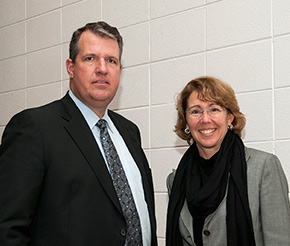Former NASA Astronaut Magnus speaks at UTSI
Tullahoma, Tenn. — Former astronaut and AIAA director Sandra Magnus captivated an audience at the UT Space Institute talking about her sixteen years of experience while she was at NASA and the perspectives she gained, lessons learned traveling around the world and highlights of the practical things in our lives. In 1996, the first year of her job as an astronaut, NASA started hiring people to fly to the Space Station. She was in the first and largest class to date and they were called the “sardines” because the crew was made up of thirty-five Americans and nine international astronauts. She talked about the cultural diversity in working with the Russians, Japanese, Canadians and Brazilians in order to get the International Space Station operational piece by piece. She stated that the largest intangible benefit from the space program was working with sixteen different countries across language barriers, sharing various approaches on engineering, all of which came together for this “awe inspiring monstrous building hanging in the air.”

She also talked about human adaptability where in just a few days in orbit she adapted quite quickly as if she had been there forever. She had to hit the floor running when she arrived at the Space Station because projects were due and she had no time to think about adapting. Humans can adapt to their environment easily or rapidly. She noticed every day looking out her window from space how beautiful our planet is. The Caribbean was her favorite spot with its carpet of blues, greens and interesting textures. At night she saw an active volcano erupt, spectacular light shows produced by thunderstorms and where people lived by city lights. She took more than 18,000 photos.
Magnus pointed out that our planet earth is fragile and that we are all connected together. Magnus stressed, “Don’t take the planet for granted!” It’s clearly obvious from space that Earth is a spaceship, a closed system like the Space Station. She stressed the importance of recycling. The planet is affected by where our trash goes just like on the Space Station where trash has to be tracked by serial numbers. She stressed the importance of recycling.
The perception shift of gravity she felt was very normal to her and natural without having any gravity. “Gravity is not your friend,” when having to adapt to zero G when reentering the atmosphere from space.
“I spent a lot of time on the ceiling because I could,” said Magnus.
She exercised for at least two hours every day to limit bone loss and muscle atrophy and to make sure she would re-adapt to gravity back on earth. The more she exercised the more adaptive she became. After returning home from space, tests showed she had no bone loss or muscle atrophy. She still felt heavy for about two weeks, though, while she was getting used to gravity again.
In closing her presentation she talked about “embracing the unknown.” She has been asked often by people, “Were you ever afraid?” Her answer was “No,” because she looked forward to going to space since she was eleven years old. At age 36, she finally got to go up in space; it’s what she loves and it’s her passion.
She said as human beings we are natural explorers but yet we fear the unknown, limiting ourselves. Challenge yourselves but use common sense. Embrace the unknown, believe in intangibles and don’t take time for granted because time is most valuable. “You can always make a dollar; but once time is gone, it is gone,” said Magnus. Lastly she said, “Be passionate about what you do; it may have been something you dreamed of doing, and you will excel.”